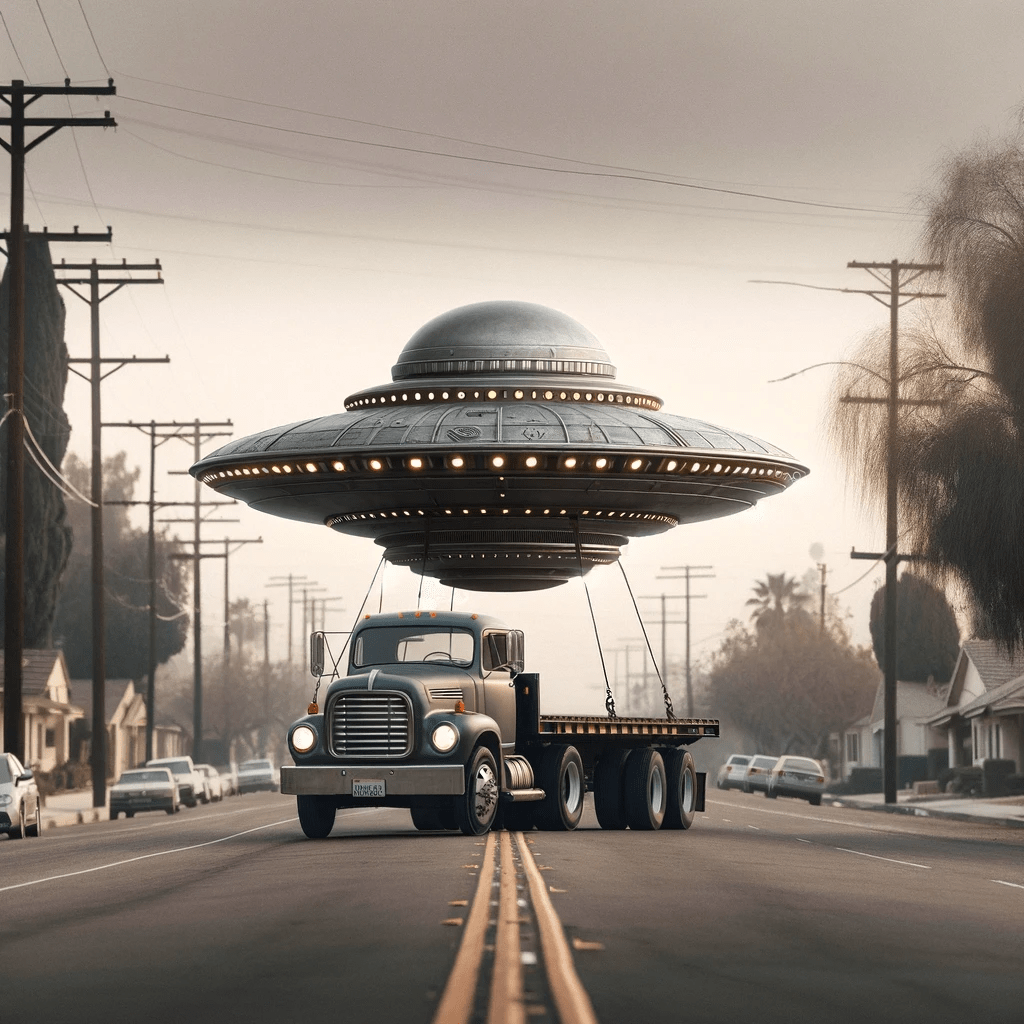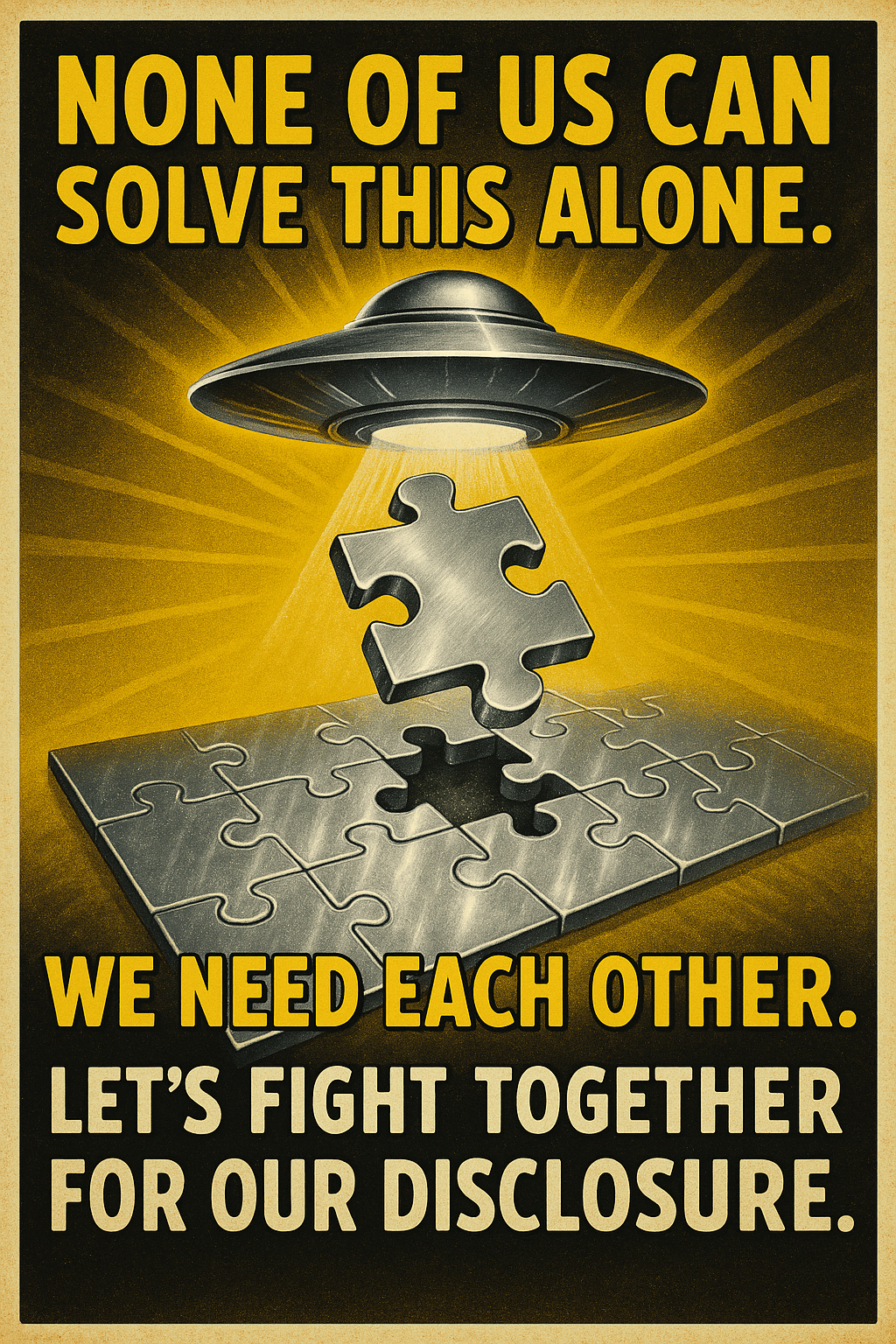UFO on a Truck in Bakersfield, California

In the quiet stretch between Bakersfield and Palmdale, California—where Lockheed’s Skunk Works Plant 42 pushes the limits of aerospace design and the skies above Edwards Air Force Base, just to the north, are under constant watch—there’s a long history of unexplained activity. Bakersfield and Palmdale lie roughly 110 miles apart, forming a corridor of aerospace secrecy and high-tech development. Edwards, known for its experimental flight programs and historic test operations, is frequently mentioned as one of the possible destinations for recovered materials or craft—including long-standing rumors that Roswell debris was once analyzed or reverse-engineered there. This region has served as the backdrop for unusual sightings, covert operations, and strange transport convoys for decades. Ever since Kenneth Arnold’s 1947 report of flying discs over Mount Rainier in Washington marked the beginning of the modern UFO era, California has remained one of the most active areas for sightings—stretching from the dry inland deserts to the mysterious offshore zones along the Pacific coast.
In recent years, multiple reports have emerged from Marina del Rey, Malibu, and Huntington Beach, where unidentified objects have been observed “tagging” air vehicles—moving with precision near helicopters, airliners, and private aircraft. Just offshore from Malibu, what’s been called the Malibu Anomaly—a submerged structure on the ocean floor believed by some to house a non-human intelligence (NHI) base.
The convoy was captured by stunned drivers and bystanders from multiple angles. It was obscured but wasn’t hidden. It moved with the kind of control and coordination you’d expect from a military operation. Support vehicles, traffic management, and a clear, uninterrupted path—all executed with quiet precision.
Whoever orchestrated the transport of this saucer-shaped craft in 2023 deserves credit—it looked exactly like the kind of UFO described in reports stretching back decades. But here’s the real question: how do you get permission to shut down two lanes of traffic and roll through Bakersfield with multiple escort vehicles like it’s a routine operation?
The transportation of this UFO fits perfectly with the timing of the UFO shootdowns of 2023. In 2023, a series of unidentified objects were shot down over North America, heightening military alertness. One was taken down by the U.S. Air Force over Alaska, landing in the Beaufort Sea. Another, intercepted by NORAD, was shot down over the Yukon, marking a NORAD first. The third was also downed by the U.S. Air Force, this time over Lake Huron. Let us never forget how close we were to potential disclosure on February 16, 2023, when many believed President Joe Biden might reveal the truth about the shootdown of unidentified aerial phenomena. This period marked a significant moment in history, stirring discussions and expectations among those following the topic.
In Bakersfield, California, and throughout the surrounding region, a pattern emerges from decades of UFO reports—one centered not just on sightings, but on the physical characteristics of the objects themselves. While the 1947 Kenneth Arnold sighting near Mount Rainier marked the cultural beginning of the modern UFO era, subsequent reports have continued to feature consistent and specific structural details.
One recurring design is that of a craft shaped like two saucers joined together—a form explicitly described in multiple credible incidents. In the Cherry Creek, New York incident (1965), witnesses described a metallic object as looking “like two plates, lip to lip.” Similarly, in the Jackson, Kentucky case (1961), a young witness described a hovering object as “two plates stacked with a cup on top.” These observations reflect the classic stacked-disc structure seen across other reports.
The classic flat-bottom, half-moon shape first described by Kenneth Arnold in 1947 has also appeared repeatedly in modern cases. Arnold observed nine objects in formation, describing them as “flat like a pie pan” and “half-moon shaped,” with a distinct blue-black sheen. A similar shape was reported during the Trindade Island case (1958), where a Brazilian Navy photographer captured images of a disc-like object described as having a half-moon profile.
Portholes have been a consistent detail across various encounters. The Gulf Breeze sightings (1987–1988) included descriptions of saucer-shaped craft with evenly spaced portholes. In the 1959 Papua New Guinea event, witnessed by multiple individuals including Anglican missionary Father William Gill, a disc-shaped craft with glowing portholes and humanoid figures on top was reported. Additional porthole descriptions came from Dr. Clyde Tombaugh (1949), who reported a row of yellow-lit openings resembling windows.
Another notable feature is the indented or “divot” dome, where the top of the craft appears recessed or dimpled. During the Coyne Helicopter Incident (1973), Army Reserve crew reported a gray metallic object with a slightly domed structure and lights embedded along a recessed upper edge. The Stephenville Lights (2008) also included witness descriptions of a massive object with a glowing, recessed dome.
Craft described as sliced or halved domes appear in several reports. In the Exeter Incident (1965), the glowing object was described as “like a dome cut in half.” Likewise, in the Derenberger/Indrid Cold encounter (1966), the craft was described as ovular with a flat bottom and a dome-like top.
Descriptions of a flat bottom appear in abduction-related cases such as the Betty and Barney Hill incident (1961) and the Travis Walton abduction (1975). Both involved saucer-shaped craft with visibly flat undersides and porthole-like features along the rim. The Bressay Island, Scotland sighting (1997), reported in UK MoD files, also noted a circular object with a very bright light and distinctly flat base.
Finally, sightings involving etched symbols or circular markings on the surface of saucer-shaped objects are well-documented. In the 1964 Socorro incident, police officer Lonnie Zamora observed a silvery craft with a red, circular insignia. The Colares UFO wave (1977) in Brazil included reports of discs with etched markings emitting beams of light. In the Rendlesham Forest incident (1980), Sgt. Jim Penniston described touching a landed craft that featured etched glyphs and circular motifs across its surface.
From California’s deserts to its coastal cities, the consistency in these physical descriptions—flat bases, recessed domes, portholes, etched markings, and stacked saucer forms—suggests a recurring and identifiable class of aerial phenomena. These features appear across decades and continents, and despite variations in behavior or size, the form factor remains remarkably stable. Whether these observations point to advanced technology or non-human intelligence, the pattern is clear: we are repeatedly seeing something structured, deliberate, and consistent in appearance.


